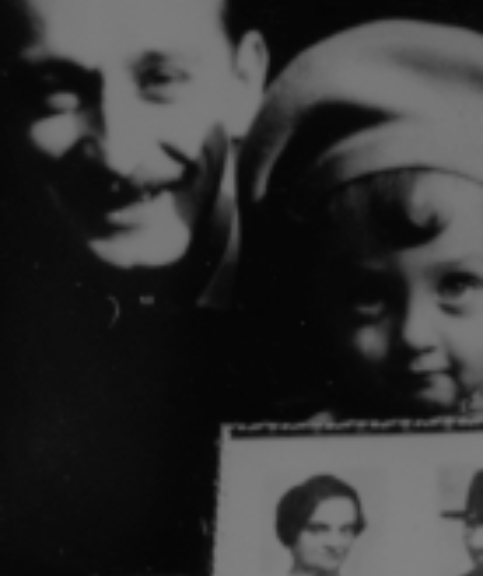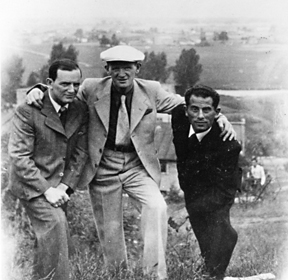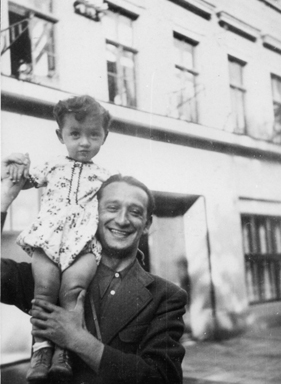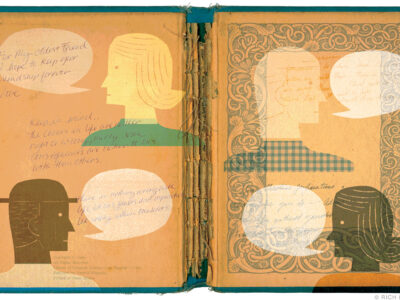
A new book of photographs recovered from Auschwitz—family portraits, birthday parties, wedding pictures, days at the beach—recalls the lives shattered by the Holocaust.
By Ann Weiss
They were the photos that no one was supposed to see, photos that showed Jews as normal people living normal lives, not the subhumans that Hitler deemed “life unworthy of life.” I found them by accident, and that accident has changed the course of the rest of my life.
It was autumn 1986, and I was traveling in Czechoslovakia and Poland with a group of prominent Jewish leaders from Philadelphia. We were being shown culturally and historically significant sites, feted at elegant soirees, and briefed by government representatives about the official state of affairs in these then-Communist countries. Throughout these travels, I visited cities and towns where Jewish life had formerly flourished. But now I saw only the evidence of what once had been, since neither the culture nor the people yet remained.
In this era of Cold War and KGB, we were surveilled everywhere we went. Agents monitored our conversations and followed our every action. Our group had been briefed, in advance, about the kinds of discussions not to have (anything critical of the government) and about the kinds of issues not to discuss (anything political).
In Poland, among other places, we were taken to see the Warsaw ghetto and Kazimierz, the Jewish section of Cracow. And we visited Auschwitz, site of the largest Nazi death camp, now a museum.
v I have always been fascinated by the stories of people’s lives—what they think, what they believe, what they cherish. The discovery I made in a locked room at Auschwitz would change my passion for stories from a serious avocation to an all-consuming pursuit.
The stories I was accustomed to hearing were the happy stories my own family would tell, gently and lovingly, when I was a child. They were my mother’s stories about relatives I never knew, streets I never walked, adventures I never had. Through her stories, I came to know the people she loved and the times she cherished. And I was able to “meet” my family, murdered years before I was born.
Both my parents are survivors of Nazi concentration camps, and both knew, firsthand, the barbarity of what one individual is capable of doing to another. But these aren’t the stories I heard, not for a very long time—not until I was older, and not until I asked.
Instead, I heard stories of life and of love, of family holidays and family vacations, of innocent carefree times, and then later, much, much later, of the devastating times that both defy words and defeat understanding. With these stories as my foundation, the firmament of my adulthood, I walked into Auschwitz for the first time.
I did not know what I would see, nor could I anticipate its impact upon me. I knew only that I was ready to face this cursed place that had taken on mythic proportions in my consciousness. Auschwitz-Birkenau. The largest of Hitler’s death camps. Auschwitz-Birkenau. Its very name had become an archetype for death.
When my group was led through the camp, now a museum, the tour guide began reciting her rote presentation, ticking off facts—dates, transport lists, numbers killed from different towns—as if they were items on a grocery list. Suddenly, in this place of death, I felt a strong need to breathe life, to be alone, and away from the droning voice of the tour guide. I needed both silence and space, to breathe, to think, to feel. As the group proceeded to the next gallery, I remained behind.
It was as simple as that. The group walked ahead, and I stayed behind.
For a long time, I remained in a room filled, floor to ceiling, with shoes, thousands of pairs of shoes left from the last few days of killing. The shoes were broken and bent, with holes in their soles, abandoned witnesses to what no words could express. I stayed with the shoes, and thought about the lives of their owners. Time ceased to exist for me, only the shoes. Eventually I “returned” to the present and found myself completely alone in Auschwitz.
v Panicked, I began to run, from gallery to gallery, and from building to building, searching for someone from my group, searching for anyone alive. Eventually, in the distance, I heard a sound and made my way toward it. I ran into an employee, a woman, who pulled me aside in the deserted hallway and, quite remarkably, asked me, “Do you want to see what’s in this room?” Though I was nervous, I immediately answered, “Yes.” A locked door was unlocked, and it was then that I saw the amazing photos that were to change my life.
What are these photos?
They are the most cherished photos carried into Auschwitz-Birkenau by Jews who were deported there. Although millions of personal photos were carried into Nazi death camps by people forced out of their homes, virtually all of these photos were confiscated and destroyed, according to Nazi order, at Auschwitz and all the other Nazi camps. Millions of photos were brought and millions were destroyed, together with their owners. This collection alone remains, and the stories of their owners, a treasured legacy.
The photographs were hidden during the war—exactly how, we don’t know—and afterward they became part of the museum established at the camp by the Polish government. There they remained over the years, in large ledger books, not unknown exactly but forgotten, or ignored.
Before I had unpacked my suitcase from that first trip, I began to plan my return to Auschwitz—to negotiate a way to copy the photographs and share them with those who had not been in the locked room. This I managed to do, eventually, and in several trips between 1988 and the early 1990s, I copied the 2,400 photographs in the collection. Some of the photos were used in a video that I made in 1989 and in a traveling photo exhibition that has been or will be shown in Europe, Canada, the United States, and the Middle East. The Last Album: Eyes from the Ashes of Auschwitz-Birkenau, published earlier this year, includes 400 of the photographs from the collection.
Unlike most Holocaust accounts, which of necessity tell the story of death, The Last Album tells the story of the life. Before they became victims, they were people living their lives. And it is these lives we see depicted in the photos they carried: Holidays, family vacations, children going to school, sweethearts falling in love, weddings, babies.
When they were forced out of their homes, they grabbed their most precious photos. And it is these photos that I saw for the first time, by accident, in a locked archive in Poland decades later. It is these photos with which I have traveled the past 15 years, searching the globe for their rightful owners, and their identifications and stories as well.
Although I had hoped to find my own family in these photos, that did not happen. Yet something else, quite remarkable, did: These photos began to feel like family. Even from strangers who had no personal history with the photos, I heard the same comment again and again: These pictures look like my own family album.
Throughout these many years, the most remarkable moments of the project have been those times when I was able to reunite people with photos—in some cases, the last photos—that belonged to their family. In many cases, these are the photos that no one knew even existed.
A few such stories follow:
Cvi Cukierman and the Gayleh Rifkeleh Pastry Shop

When my photo exhibition was in Michigan, a woman asked me, “Do you know who this is?” The man, son of a prominent family in Bendin, Poland, who owned the most popular pastry shop in town, had been identified to me many, many times before. Instead of just listening politely and letting this Holocaust survivor tell me the story (again), I turned to her in frustration and admitted, “Yes, he has been identified many times, but I have never met anyone from the family.” She beamed at me, and said, “That’s because there is only one person left in the world, he lives in Israel, and he’s my friend!”
The next week, I was on a plane to Israel, and I met Cvi Cukierman, the last member of the original Cukierman family. He was the nephew of the man in
the photo, Binim Cukierman, a much beloved figure in the town. Binim was a baker by profession, but he loved to have a good time, and every day, at 2:00 (having started work at 4:00 in the morning), he took off his apron, got himself spruced up, and went to meet friends. Sometimes he went to the sports club, where he was a talented soccer player. Sometimes he played violin in the orchestra, or played cards with his friends. Other times he would ski or swim or hike, often taking his young nieces and nephews on vacations with him. Cvi remembers learning how to ski at the famous resort of Zakopane with his uncle.
Cvi’s personal history is both dramatic and heroic. He made a daring escape from a Nazi concentration camp, knowing that if he stayed much longer, he would surely die. His uncle and cousins, both prisoners in the same camp, survived only a few more weeks. Later Cvi made his way to the Middle East, smuggling himself through borders, and swimming the last few miles when the British refused to allow his ship to enter. He fought in Israel’s 1948 War of Independence, side by side with his Palmach commander, Yitzhak Rabin, and helped to get food to the starving people in Jerusalem during the siege. He married his sweetheart, Minna, also a survivor of the Holocaust, and together they created a new family. When he thinks of his murdered family, he looks around his table now, filled with children and grandchildren, and he declares powerfully, “This is my revenge on Hitler!”
When I brought him the photos of his family, including his father, aunts, uncles, grandparents, and cousins, he shed the first tears he has shed in 50 years, and said to me, “You have released my tears. Now I can show my family who I am, who I come from. Now I can die a rich man!”
Huppert Family

The father, Artur Huppert, looked like a movie star. He was photographed many times, in dramatic poses, with each photo illuminating an aspect of his privileged lifestyle. Elegant settings. Elegant clothing. But when he and his wife, Grete, had their first—and only—child, it was clear that all attention now was focused on their beloved little Peter. Little else mattered as much as capturing Peter’s smile and sharing vignettes of his life with family far away. Though I traveled to many locations looking for members of the Huppert family, in the end, it was from the inscriptions on the photos themselves that I learned about the family.
On the backs of the photos were inscriptions of exuberance characteristic of new parents:
My Peterle is laughing at the world. He thinks it all belongs to him. He should be [laughing] and healthy until 120.
(“Until 120” expresses a traditional Jewish wish for attainment of the full measure of life, 120 years, the age of biblical Moses when he died.)
Though Artur and Grete lived in the former Czechoslovakia, they frequently sent inscribed photos to family members in Poland. And Artur even managed to devise a three-generation portrait, with Peterle and Artur holding portraits of geographically separated family.
As the political situation became more dangerous, Artur’s inscriptions begin to reflect his heightened concern:
v My child Peterle, 20 months and I turned 31 on 9 July 1940 … My poor child doesn’t know what a bitter world he was born into, nor ought he to know that. 30 June 1940
Ironically, when I had almost despaired of ever finding a living member of the Huppert Family, I met Artur’s namesake right here in Philadelphia. Although the Philadelphia Arthur is a distant Huppert relative from the Polish, not the Czechoslovakian, part of the family, it is clear that genetics trumps geography: He has the same unmistakable and beautiful Huppert eyes!
Genya Gutfreund Manela
She was the girls’ leader of Ha Noar Ha Tzioni, a Zionist youth group in Bendin, Poland. Her love, David Manela, was the leader of the boys’ counterpart. Both taught their charges about being true to one’s ideas, about the Land of Israel, and about trying to make the world a better place.
Tola Gilbert, who was 14 when Genya, about 21 at the time, had been her Rosh K’futzah (group leader) remembers with excitement: “She was wonderful and so kind. She taught us about philosophy, about literature. I remember our discussion about Ibsen’s Enemy of the People until today. When we were suffering in Auschwitz, knowing she was in Israel gave us hope.”
Genya and David married and made aliyah (emigrated, literally ascended) to Israel around 1939. (The photograph included here was one she distributed to friends before she left.) Although David’s mother gave him tuition money for his engineering studies at the famed Technion in Israel, he gave it all to the cooperative community where he and Genya lived, Kibbutz Tel Yitzhak.
Kibbutz members still vividly remember the family: David worked for the kibbutz until the last day of his life, at age 79. At night, he tried to study engineering on his own and do special projects. Genya studied nursing in Jerusalem and learned to be a midwife. Their son Gaddi had the movie-star good looks and personality that came directly from Genya.
Gaddi was a soldier and, in 1968, at the age of 21, while trying to protect an Arab woman, he was killed by Arabs. Genya and David died within six months of each other, first Genya in 1995 and then David in 1996.
Genya and David also had a daughter, Noa. When her fiancé was killed in an accident, she left the kibbutz to which her parents had devoted their lives. She spoke to me from Southern Israel, now the sole survivor of her family: “My parents gave their lives to Israel and they had a good life here. [They] thought only about Israel, never about themselves. It is how they lived; it is how they died.”
Tola Gilbert concluded, when thinking about Genya and her family’s life, “You can escape Auschwitz, but you can’t escape your fate.”
Though there are many photos already identified and many photos already in the rightful hands of family members, there are still many more left to discover. As of this writing, I continue the effort to unite families with their photos, and to preserve memories of the past as stories for the future.
Ann Weiss ASC’94 is currently a doctoral candidate at the Graduate School of Education, Division of Educational Leadership, examining Holocaust family culture and family stories. This article is adapted from her book, The Last Album: Eyes from the Ashes of Auschwitz-Birkenau, published by W.W. Norton. A photographic exhibition is currently touring nationally, with Hadassah and Senator Joe Lieberman as the National Honorary Chairs. For further information, see (www.eyesfromtheashes.com).




